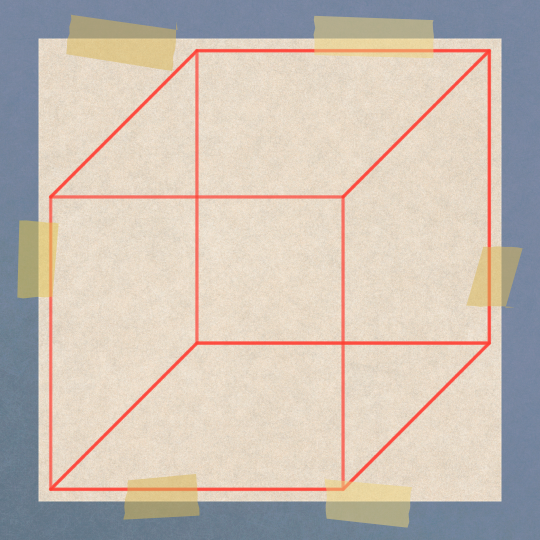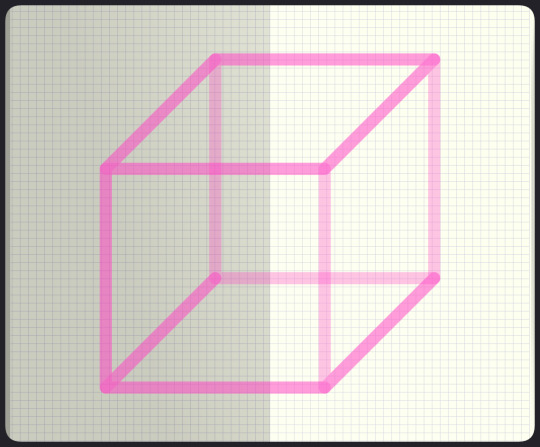#necker's cube
Photo

unspinnable cube
11K notes
·
View notes
Photo
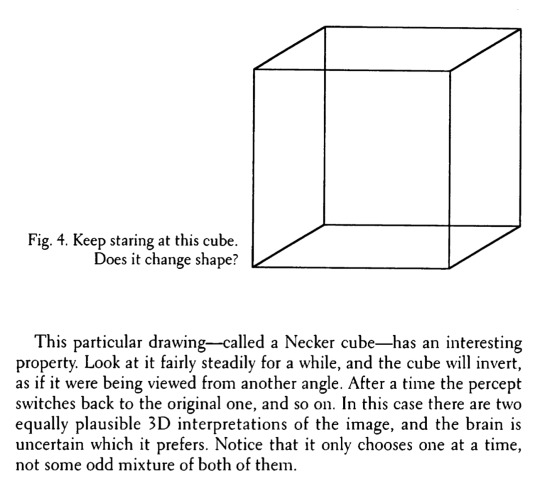
Francis Crick, The Astonishing Hypothesis
359 notes
·
View notes
Text
I Saw The Light
One of my greatest failures in life turned out to be one of my greatest achievements.
It was during my first semester in college, pursuing my love for the ocean and my goal of becoming a Marine Biologist, that I signed up for a course called Ecology. I thought it would be a breeze compared to my other courses; after all, it was just about littering and such, Right? However, on the first day of…

View On WordPress
2 notes
·
View notes
Text
The Necker Cube: a symbol for the androgyne community

The Necker cube is a bidimensional optical illusion first published in 1832 by Louis Albert Necker. It's particular because the person who observes this cube has no clue of the "real" direction of the image, as it can be both concave and convex based on how you look at it, giving us a multistable perception of it.
Cameron Reed in 1996 has first proposed the Necker Cube as a symbol for the androgyne community, since the ambiguity of this cube can be found in androgyny (physical, mental, or both).
BIBLIOGRAPHY
What is the necker cube:
https://en.m.wikipedia.org/wiki/Necker_cube
A symbol for the androgyne community:
Who is Cameron Reed:
https://en.m.wikipedia.org/wiki/Cameron_Reed
#AndrogyneCultureIs#androgyne#androgyny#androgynous#androgyne pride#history#community#lgbtq community#lgbt#lgbtq#lgbtqia+#transgender#nonbinary#bigender#genderfluid#gender presentation#gender expression#gender euphoria#gender identity#gender nonconforming#gender noncomformity#neckercube#cameronreed
11 notes
·
View notes
Text
necker cube sex. change your perspective and who's the top flips
19 notes
·
View notes
Text
i hate posts with mayas pic beside uma and ethan pics because my brain overheats every time i try to decide who she looks like more and the answer changes every half a second because i genuinely cant tell its both its neither its like hearing "what english sounds to people who dont speak english" audios its like looking at ai generated images where you see objects but cant make them out its like the necker cube
9 notes
·
View notes
Text
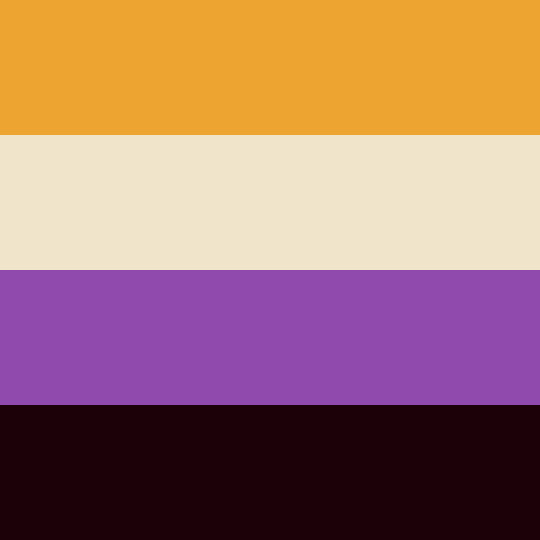

making this flag more bearable to look at (feat. the necker cube for androgyny because i like it)
2 notes
·
View notes
Text
Unlocking the Wonders of Visual Perception: Exploring Optical Illusions

Do you believe your eyes? Well, sometimes they can play tricks on you! Optical illusions are captivating phenomena that challenge our perception and reveal the intricate ways our brain processes visual information. In this article, we’ll delve into the fascinating world of optical illusions, unraveling their secrets and understanding the science behind them.
Introduction
Optical illusions are captivating visual puzzles that showcase the complex interaction between our eyes and our brain. From making static images appear in motion to perceiving color where there is none, these illusions offer a glimpse into the remarkable way our minds interpret the world around us.
What Are Optical Illusions?
Optical illusions are images that deceive our visual system, causing us to perceive something different from reality. They exploit the brain’s tendency to make assumptions and fill in gaps when processing visual information. In essence, this highlight the disparity between what we see and what actually exists.

The Role of Perception
Perception is a key player in the world of optical illusions. Our brain often takes shortcuts to quickly interpret our surroundings, but these shortcuts can lead to misinterpretations. These illusions capitalize on the brain’s habits, leading us to see what isn’t actually there.
Types of Optical Illusions
Geometrical Illusions
Geometrical illusions manipulate our sense of size, length, and orientation. They trick us into seeing shapes and patterns that seem distorted or disproportionate.
Ambiguous Illusions
Ambiguous illusions present images that can be interpreted in multiple ways. This ambiguity causes our brain to flip between different interpretations.

Motion Illusions
Motion illusions create a sense of movement in static images. They challenge our brain to perceive motion where there is none.
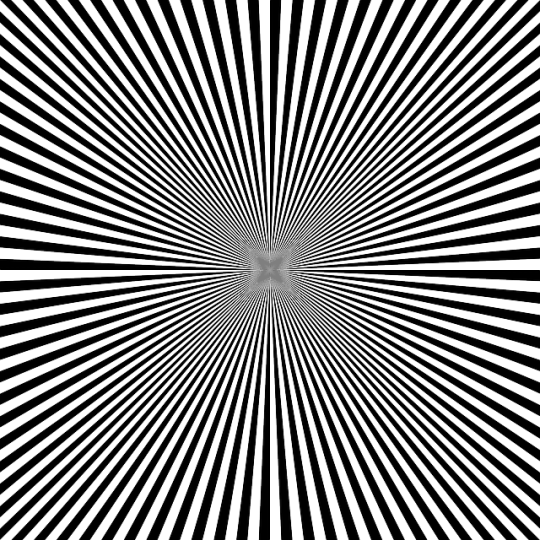
Color Illusions
Color illusions exploit the way our brain perceives colors based on surrounding context. They can make us see colors that aren’t actually present.

The Science Behind the Illusion
It occur due to the brain’s attempt to simplify the complex visual information it receives. Our brain relies on past experiences and assumptions to make quick judgments about what we’re seeing.
Perplexing the Brain: How Do They Work?
This expose the disconnect between our visual perception and physical reality. By manipulating factors like contrast, brightness, and perspective, these illusions highlight the brain’s vulnerability to certain visual stimuli.
The Connection Between Illusions and Reality
Despite their deceptive nature, optical illusions have a strong connection to reality. They demonstrate how our perception isn’t always an accurate representation of the world but is rather a construction of our brain’s interpretation.
Bursting the Illusion: Why Do We Fall for Them?
Our brain’s predisposition to take shortcuts and make assumptions can lead us to fall for optical illusions. These illusions reveal the gap between our brain’s expectations and the actual visual input.
Famous Optical Illusions Throughout History
From the classic Penrose triangle to the enigmatic Necker cube, history is brimming with optical illusions that have baffled and intrigued generations.
Creating Illusions: Art and Design
Artists and designers often use optical illusions to play with viewers’ perceptions, creating captivating and thought-provoking pieces that challenge reality.
Practical Applications of Optical Illusions
Beyond entertainment, optical illusions have practical uses. They can help scientists study the brain’s processes and aid in designing spaces that appear larger or more pleasing.
Can Illusions Trick Artificial Intelligence?
Just like our brains, artificial intelligence can also be vulnerable to optical illusions, which has implications for fields like computer vision and autonomous driving.
Unveiling the Mystery: Can You Train Your Brain?
Research suggests that with practice, our brains can become more resistant to certain illusions. Training our brain can reveal the secrets behind some of these captivating tricks.
The Impact of Illusions on Visual Arts
It left an indelible mark on the world of visual arts, inspiring movements like Op Art and influencing renowned artists throughout history.
Conclusion
In conclusion, optical illusions are windows into the complex relationship between our eyes and brain. They remind us that perception is a dynamic and often deceptive process, shaped by our past experiences and cognitive shortcuts. The next time you encounter an optical illusion, take a moment to appreciate the incredible interplay of perception and reality.
Explore the allure of eyewear fashion with our exclusive collection at Rebecca Optical. Discover frames that marry style and comfort, elevating your visual experience to a whole new level.”
Get your Appointment Now !
Secure your spot at:
for a personalized eyewear consultation and experience exceptional vision at its finest. Reserve your appointment now and embark on a journey towards stylish and clear sight.
0 notes
Text
Only 1% of the best geniuses can spot an eagle in the mountains in 6 seconds! - NEWSTARS Education
Optical illusions, those captivating visual phenomena, never fail to leave us both challenged and fascinated. These puzzling images or pictures have the power to captivate and deceive our minds, making us question our own perception and understanding of reality. From the famous "Rubin's vase" illusion to the mind-boggling "Necker cube," optical illusions have been a source of intrigue for centuries. They play with our brain's ability to interpret visual information, often presenting conflicting cues that trick our minds into perceiving something that isn't actually there. What makes optical illusions so fascinating is that they remind us of the limitations of our senses and the subjectivity of our perception. They show us that what we see is not always an accurate representation of reality. It is a powerful reminder that our brains are constantly processing information a - hqbe19sw1h
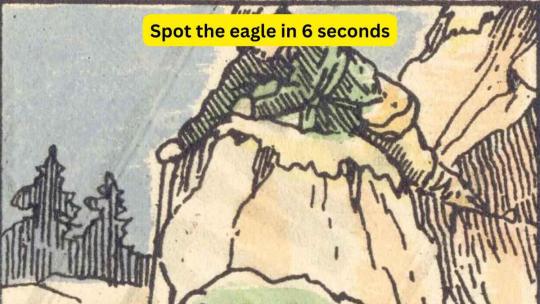
1 note
·
View note
Text
I Can hold both views of a necker cube in my mind simultaneously actually
0 notes
Text
Top down processing example

Working in machine vision must be fascinating. However, whenever one particular interpretation is selected, the others are suppressed to avoid conflicting interpretations of a visual scene. Since more than one interpretation is possible, your brain alternates between them. It would seem that your brain takes the visual information provided about the cube's edges and then tries to fit an interpretation on it. At no point, though, can both orientations be held in one's head at once (at least, I cannot manage to do that). However, after staring at the cube for a few moments, they can cause it to 'flip' into the other orientation. It is ambiguous, though, whether it is intended to be in one of two possible orientations: are you looking slightly down onto the cube, or slightly up at it (in other words, are the bottom two corners corners on the front or back face of the cube)? For most people, there is a default orientation when they first see it. This simple drawing forms a three dimensional clear cube. When it does, it is sitting in your blind spot, and your brain fills in that area with it's best guess (in this case, blank white paper).Īnother example that occurs slightly higher up in your visual processing is the Necker Cube, shown here. At a certain point, the X on the periphery of your vision should disappear. Hold the paper about half an arm's length in front of you and gradually move it closer. Then close one of your eyes and stare at the opposite mark with your open eye (for example, if you closed your left eye, look at the left X with your right eye). A quick way to demonstrate this is to take a piece of scrap paper and put two X's on it about eight centimeters apart. You do not realise this, though, because your brian manages to fill in that area of your visual field with its best guess as to what is there. However, if you close one eye and keep your other eye locked on a specific target, your blind spot becomes anchored in place. Also, your eyes are almost constantly performing saccades (small jumps around to focus on different regions of the visual field). This is normally not a problem since the blindspot of each eye falls on a different area of your visual field, so the sensory perceptions of one eye can compensate for the other. In your retina you have a small area devoid of receptors where nerves and blood vessels enter and leave your eye. One example of top-down processing that is fairly easy to demonstrate is the blind spot. Effectively introducing top-down processing into artificial visual systems, however, is quite difficult, and it would seem that the top-down algorithms instituted by our brains (and their handy parallel architecture) are what keep us currently so far ahead of computers. What is fairly surprising, though, is top-down processing is also clearly involved in visual processing. Your brain clearly does some bottom-up processing, since you react to raw changes in the visual stimuli even if there was no reason to expect that change. Top-down processing means you start with an idea of what you ought to be seeing (most likely determined by recent sensory information, other sensory clues, and your past experience). Optical illusions and trick images are one relatively simple way to explore the way our brain processes visual information, and they are also fairly fun to look at.īottom-up processing basically means your brain reads in the raw visual information captured by the retina and gradually figures out what it means as one moves farther along the processing chain that is your cerebral cortex. As with most things (especially in psychology), neither one is entirely correct and your brain utilizes a combination of the two. One of the interesting debates in perception psychology and neuroscience is whether the brain performs bottom-up or top-down processing. It shouldn't be entirely surprising, though, that our visual system is as incredibly powerful as it is, since a huge proportion of our brain is utilized primarily for visual processing. One of the subjects I have written about before is machine vision and the incredible difficulty of developing a robust visual processing system that can equal the robustness of our own visual system.

0 notes
Text
Maybe we need to look at fighting viruses and cancer in a different way. I am neither a virologist or oncologist—heck, I didn’t even sleep at a Holiday Inn Express last night, but it appears to me the strategy in fighting these aliens seems to focus on blocking the payloads from entering and infecting healthy cells. That makes sense.
The image is what is called a Necker Cube– an optical…
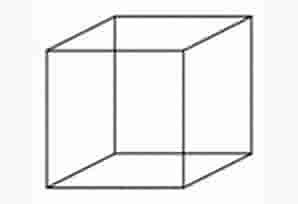
View On WordPress
0 notes
Text
FLAGS
Let's talk about flags! As with all other parts of the LGBTQIA+, also for Androgyne there are a lot of pride flags. Some of them have meanings that are known, for others they are not known, but let's go step by step:
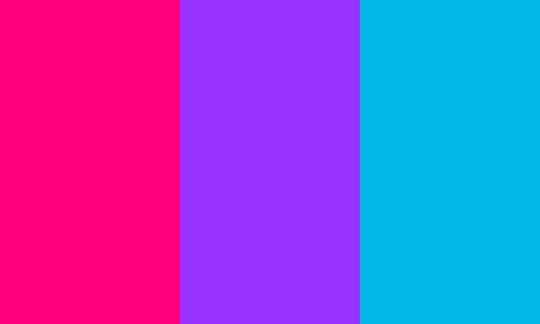
The aesthetics of my blog, and even my posts themselves, contain colors taken from or photos of this flag. This why? Because This is the official androgyne pride flag, or the most used / common / known, and also for more practical reasons I decided to base the aesthetic part of this blog on this flag, so that those who chew the topic or already know about it, can immediately catch the eye through the vision of these classic colors.
The pink means femininity, the light blue masculinity, and the purple a mix of them both, you can probably understand it even without explanations, and this is precisely the beauty of this flag: it is easy to understand, simple, symbolic.
(Fun fuct, that's also how I found out about androgyne! I had only seen a photo of the flag with the name of the gender it represents in description, and I had understood everything even before informing myself about it)
Perhaps some of you will think that colors are very stereotyped, and if this is partly true, on the other hand androgyny as identity and movement aims to break gender roles and the suffocating binary system, taking both or completely denying them.
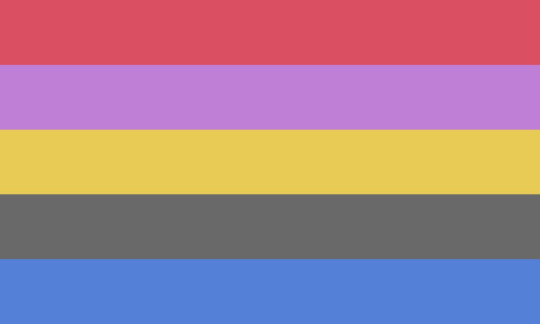
This is the most known alternative of the original flag. The red means woman, the blue man, the purple a mix of the two, but there is also the yellow that represent nonbinary-ness and grey for neutrality.

Also this is a very common alternative, and my favorite for the meaning.
The black and the white stand for the fact that androgyne could be more binary than other identities, the pink is the femininity (understood as gender or aesthetically) the light blue is masculinity (again with gender-meaning or aesthetically) and they are divided from the purple, that is a comfortable blending of the two that made up the unique identity of androgynes.

This is very particular! And it brokes the pink-purple-blue system. In fact it is less known that the orange is a color that means masculinity, and purple can mean femininity, despite to being used as a symbol of the mix between the two binary genders.
In the middle we have white, that means the absence of gender (like the nonbinary and the genderqueer flags), with the Necker Cube, an optical illusion symbol of the androgyne community, because it is concave or convex based on how you look at it.

I really love the stripes of this flag!
The dark blue stripe means masculinity, the light blue stripe means community, the purple stripe androgyne identity, the light pink represents love, and finally the dark pink represents femininity.

Here we have green, that is a gender neutral color, that represents the androgyny achieved through the negation of masculine and feminine caracteristics. But we have also the purple, which represents androgyny obtained instead from the combination of masculinity and femininity caracteristics. Purple and green are also complementary colors and they symbolizes the fact that the androgyne is an identity that is both masculine and feminine, but also a gender on its own.
FOLLOWING THE FLAGS THAT DON'T HAVE A CERTAIN MEANING:
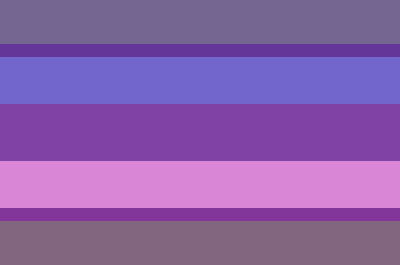
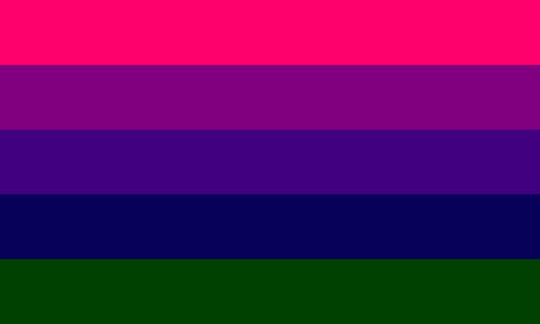
For me it's not a big deal anyway, I believe that the colors speak by their own ^-^
OUTDATED FLAGS:

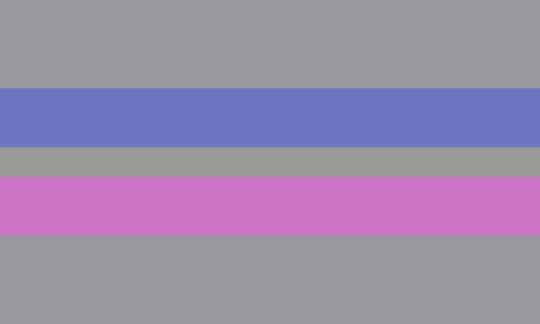
The meaning is a little bit uncertin but it's believed that grey represents neutrality/outside the binary and the two stripes represent the equality of the two genders
AND NOW:
It's up to you to choose the flag that fits your experience best :)
What's your favorite flag?
SOURCE:
#androgyne#androgynous#androgyny#androgyne positivity#androgyne pride#androgyne flag#androgynylooksgoodonme#lgbt#lgbtq#lgbtqi#lgbtqa#lgbtqia#lgbtqia+#lgbtq positivity#lgbt representation#lgbt pride#lgbt positivity#AndrogyneCultureIs#pride flags#flags#color#colors#questioning
10 notes
·
View notes
Text
rotating disco elysium in my brain. is it a book for gamers or a game for readers...necker cube
10 notes
·
View notes
